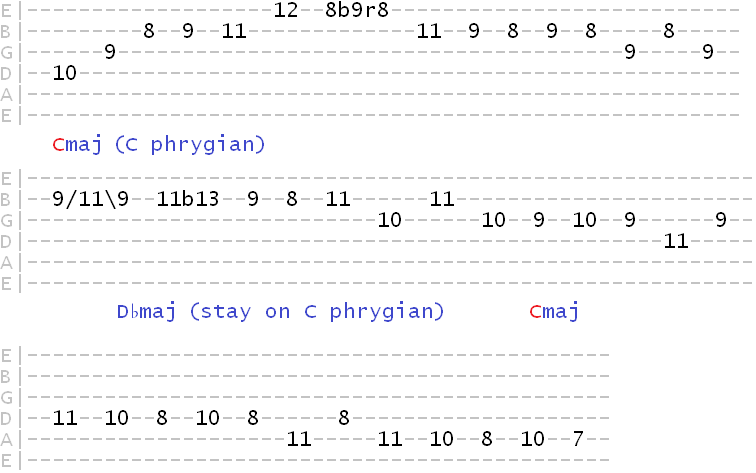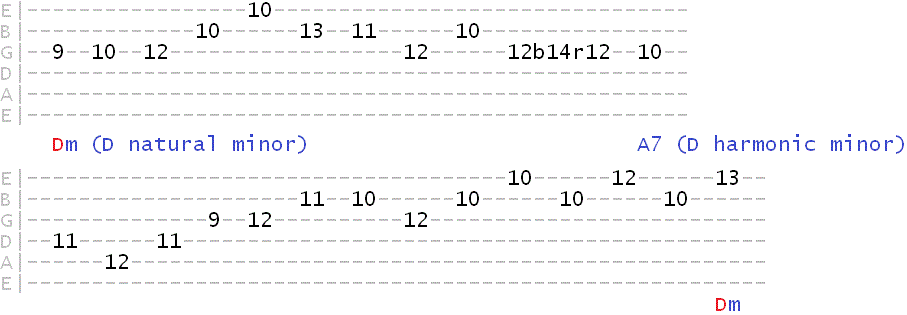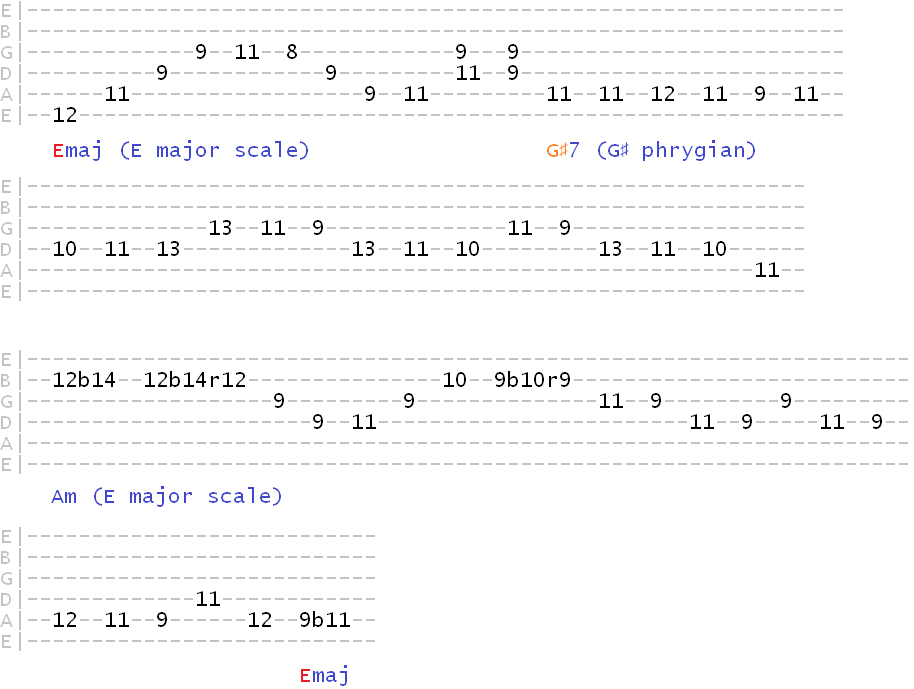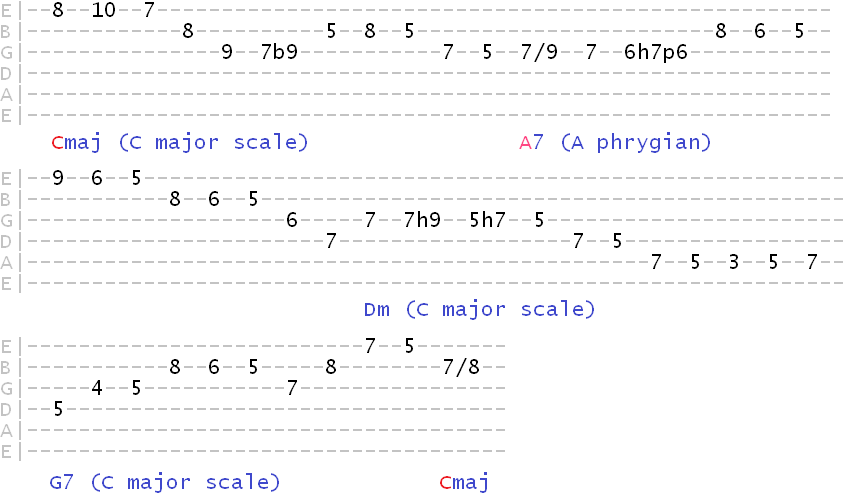Phrygian Dominant Theory - The Ingredients
Like all scales, phrygian dominant has its own sequence of intervals that create its unique sound.
Let's start by comparing it to the more common major scale. (Key: w = whole step, h = half step, wh = whole + half)

As you can see, like the major scale, phrygian dominant contains the intervals of a major triad (1, 3, 5), which tells us its root/tonic chord is major and therefore the scale will work over major chords (although not every instance).
But what gives it its unique flavour and tension is the presence of a minor 2nd (♭2) and minor 6th (♭6) - two quite harsh intervals when played over a major chord, but when combined in a sequence with the other tones, we get a beautiful but quite dark sounding major scale...
Hear the C major scale
Hear C phrygian dominant
Phrygian Dominant On The Fretboard
To begin with, learn this "three-notes-per-string" pattern to get to know the scale. Remember, whatever note on which we position our root/1, that becomes the root of the scale (e.g. C phrygian dominant, E phrygian dominant etc.)...


Playing Over Single Chords
Use the pattern above to explore the scale over the chord tracks below. They're "drone" tracks, which means the chord plays out without any changes or interruptions. You can set your own metronome beat to the tracks if you wish.
As The 5th Mode Of Harmonic Minor
Harmonic minor and phrygian dominant are intrinsically related, because they in fact share the same notes.
Phrygian dominant is the 5th mode of harmonic minor, which means it begins on the 5th degree of the harmonic minor scale.
A harmonic minor = E phrygian dominant (because E is the 5th note of A harmonic minor)
C harmonic minor = G phrygian dominant (because G is the 5th note of C harmonic minor)
Many musicians prefer to see phrygian dominant in this way, using harmonic minor as the reference point. For example, take the harmonic minor pattern below. If we start on its 5th degree and re-label the intervals from there, we get phrygian dominant...


Phrygian Dominant Harmony
There are some common chord sequences that use notes from the phrygian dominant scale.
I've always stressed the huge benefits of ear training, so you can recognise such chord sequences when they're played and know intuitively how to accompany them.
As explained in the video, the most common chords used from the phrygian dominant scale are the 1 (I), 2 (II), 4 (iv) and 7 (vii) chords.
Here's how those chords would appear in several keys. Strum between these chords in your chosen key to get an ear for them...

The strongest indication a piece of music is in phrygian dominant is the movement from the tonic to the major II chord, one half step/semitone up. For example, in C major, that movement would be, in its most basic form: Cmaj > D♭maj, typically moving back and forth between the two.
Hear me playing C phrygian dominant over both the I and II chords...

Also from the table, note the movement from the tonic down a whole step to the minor vii chord. In C major, that would be Cmaj > B♭m. Another strong indicator of phrygian dominant.
While there are other chords (built on the remaining degrees of the scale), if you can learn to pick out movements between the above chords by ear, you'll know when phrygian dominant is the most likely scale of choice.
Below I've picked out some backing tracks written specifically for phrygian dominant that use these chords. Jam along if you like!
Phrygian Tension
As phrygian dominant carries a lot of tension, it will complement certain instances of major and dominant 7th chords in a progression where this tension is created. Some examples...
Minor Key i - V
The most common example of this use of tension is in the minor key relationship between tonic (i) and dominant (V). For example, Am might be our tonic and therefore Emaj or E7 would be our "tension" chord. This is the chord over which phrygian dominant would work most naturally.
The below table shows you what these i - V chords would be in several keys...

As phyrgian dominant uses the same notes as harmonic minor, many musicians prefer to simply change from natural minor over the i tonic to harmonic minor (same root) over the V chord. This will give you the phrygian dominant colour over that V chord. This is because the 5th of harmonic minor becomes the root for that V chord, building on what we learned earlier.
For example, in the key of Dm, Amaj/A7 would be the V chord. So we'd change to D harmonic minor when the chord changes to A to get that phrygian sound...

Major Key III Chord
In major keys, the 3 (iii) chord is typically a minor chord. But often you'll hear it substituted with a major or dominant 7th chord. This creates a similar tension to the minor key V chord from earlier.
The aim is to train your ear to pick up on when this major III chord is used, so you can switch to phrygian dominant over that III chord. The table and example below will help you with this...


Major Key VI Chord
Again, typically the 6 (vi) chord in major keys is a minor chord. But often it's replaced with a major or dominant 7th VI chord. This creates that familiar tension that, again, phrygian dominant would complement.


Keep Exploring The Scale in Your Own Way
Don't worry so much at this stage about creating technical solos using phrygian dominant. There'll be plenty of time to learn larger patterns and forms for navigating the scale fluidly.
Focus on training your ear to the overall sound and mood phrygian dominant creates, both melodically (note sequences) and harmonically (chord sequences).
Give it enough of your time, and eventually you'll be able to hear the "phrygian sound" when it occurs in music and feel it in the solos you write/improvise.
More to come soon!
